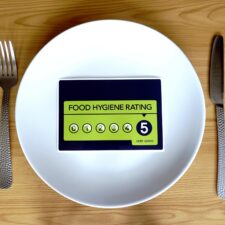
What is a food hygiene rating?
Run by the Food Standards Agency, the Food Hygiene Rating Scheme (FHRS) operates in England, Wales, and Northern Ireland. Once you’ve registered your food business with the local authority, they may send an inspector to give you a hygiene rating.
The food hygiene rating provides consumers with a clear indication of hygiene standards, using a straightforward 1-5 score:
- 5 – hygiene standards are very good
- 4 – hygiene standards are good
- 3 – hygiene standards are generally satisfactory
- 2 – some improvement is necessary
- 1 – major improvement is necessary
- 0 – urgent improvement is required
In Wales and Northern Ireland, it’s a legal requirement for businesses to display their ratings, and it’s likely this will eventually become a requirement for English businesses too.
Scotland has its own version of the scheme (known as the Food Hygiene Information Scheme) in which food-handling businesses are either given a pass, or are told that further improvements are needed.

What do food hygiene inspectors look for?
To get a rating, Environmental Health Officers (EHOs) will visit the business to carry out a full hygiene inspection. They focus on three major areas:
- food hygiene compliance – including an assessment of how food is handled, prepared, and stored
- structural compliance – how clean is the building and its facilities? Is the lighting suitable?
- management confidence – are staff being trained correctly to maintain hygiene standards? And what policies and procedures support this?
If a business performs strongly in all three areas it’ll be granted the 5 star food hygiene rating. However, if a business performs poorly, it’ll have to undergo more regular checks.
Food hygiene tips for a 5 star rating
It can seem overwhelming, so this food hygiene guide for businesses is designed to help you understand how to get that all-important 5 star rating.
Food storage
- avoid common mistakes like storing raw items alongside ready-to-eat foods. Remember that raw foods are not just meat and fish – uncooked and unwashed vegetables must also be stored separately
- make sure you have a clearly labelled storage system with use-by dates displayed
- remember that food should always be stored on racks and not on the floor
Food preparation
- avoid washing raw and ready-to-eat foods in the same sink to reduce the risk of cross-contamination
- if you’re in a smaller workspace and you don’t have access to multiple sinks, you’ll need to establish a food preparation schedule and stick to it. For example, prepare any ready-to-eat foods first thing, then clean the area thoroughly before moving onto raw vegetables
- if you have a larger kitchen area, make sure there are separate workspaces for raw fish, meat, vegetables and ready-to-eat foods. If you’re working in a smaller space, plan the work day accordingly, prepping each food type at separate points in the day, and making sure utensils and surfaces are properly cleaned in between each stage of preparation
Cleaning
This one goes without saying, but it’s always better to err on the side of caution when it comes to keeping your workspaces clean.
- keep a cleaning schedule and stick to it, breaking down each task and making sure the workspace is cleaned in a consistent manner every day
- make sure the handwashing sink is kept clean, and is always stocked with antibacterial soap. Blue roll should be easily accessible, so that anyone in the kitchen can dry their hands or mop up spills quickly
- empty bins as regularly as possible, and never allow them to overflow
- fridges should always be deep cleaned at the end of each month, while ovens should be cleaned on a weekly basis
Staff training
- it’s important that any kitchen staff have thorough training on how to safely prepare food and reduce the risks of cross-contamination
- staff should know the importance of wearing protective clothing and head coverings, shouldn’t wear jewellery or watches in the kitchen, and should be fully aware of hand washing best practices
- refresher training should also take place on a regular basis for everyone who’s expected to work in the kitchen. Make sure the training is tailored specifically to your business
Record keeping
- you must be able to demonstrate that up-to-date records are being kept of all of the above activities
- you’ll also need to document a food safety policy together with daily check sheets for fridge and freezer temperatures, as well as food temperatures
- any gaps in documentation will have an impact on the final rating
